NCERT Solutions for Class 7 Maths Chapter 4 Expressions Using Letter- Numbers
Page No. 81
Example 1: Shabnam is 3 years older than Aftab. When Aftab’s age 10 years, Shabnam’s age will be 13 years. Now Aftab’s age is 18 years, what will Shabnam’s age be? _______
Ans: Shabnam’s age will be 18 + 3 = 21 years
Use this expression to find Aftab’s age if Shabnam’s age is 20.
Ans: According to the expression,
Aftab’s age = Shabnam’s Age – 3
∴ Aftab’s age = 20 – 3 = 17 years
Page No. 82
Q: Given the age of Shabnam, write an expression to find Aftab’s age.
Ans: We know that Aftab is 3 years younger than Shabnam. So, Aftab’s age will be 3 less than Shabnam’s. This can be described as
Aftab’s age = Shabnam’s age – 3.
If we again use the letter a to denote Aftab’s age and the letter s to denote Shabnam’s age, then the algebraic expression would be: a = s – 3, meaning 3 less than s.
Q: Use this expression to find Aftab’s age if Shabnam’s age is 20.
Ans: If Shabnam’s age = 20,
Using above expression,
Aftab’s age = Shabnam’s age – 3.
= 20 - 3 = 17
Page No. 83
Example 3: Ketaki prepares and supplies coconut-jaggery laddus. The price of a coconut is ₹35 and the price of 1 kg jaggery is ₹60. How much should she pay if she buys 10 coconuts and 5 kg jaggery?
Ans: Cost of 10 coconuts = 10 × ₹35
Cost of 5 kg jaggery = 5 × ₹60
Total cost = 10 × ₹35 + 5 × ₹60 = ₹350 + ₹300 = ₹650.
Q: How much should she pay if she buys 8 coconuts and 9 kg jaggery?
Ans: Cost of 8 coconuts = 8 × ₹35
Cost of 9 kg jaggery = 9 × ₹60
Total cost = 8 × ₹35 + 9 × ₹60 = ₹280 + ₹540 = ₹820.
Q: Use this expression: c × 35 + j × 60, to find the total amount to be paid for 7 coconuts and 4 kg jaggery.
Here, ‘c’ represents the number of coconuts and ‘j’ represents the number of kgs of jaggery.
Ans: Substitute c = 7 and j = 4 into the expression: c × 35 + j × 60 = 7 × 35 + 4 × 60
Now calculate:
Figure it Out
Q1: Write formulas for the perimeter of:
(a) triangle with all sides equal.
(b) a regular pentagon (as we have learnt last year, we use the word ‘regular’ to say that all side lengths and angle measures are equal)
(c) a regular hexagon
Ans:
(a) Let sidelength of each side of triangle = a
So, perimeter of triangle with all sides equal = 3a.
(b) Let sidelength of a regular pentagon = a
So, perimeter of the regular pentagon = 5a
(c) Let sidelength of a regular hexagon = a
So, perimeter of the regular hexagon = 6a
Q2: Munirathna has a 20 m long pipe. However, he wants a longer watering pipe for his garden. He joins another pipe of some length to this one. Give the expression for the combined length of the pipe. Use the letter-number 'k' to denote the length in meters of the other pipe.
Ans: Length of pipe Munirathna has = 20 m
Length of another pipe he wants to join in meters = k
The combined length of the pipe = (20 + k) m
Q3: What is the total amount Krithika has, if she has the following numbers of notes of ₹100, ₹20 and ₹5? Complete the following table:
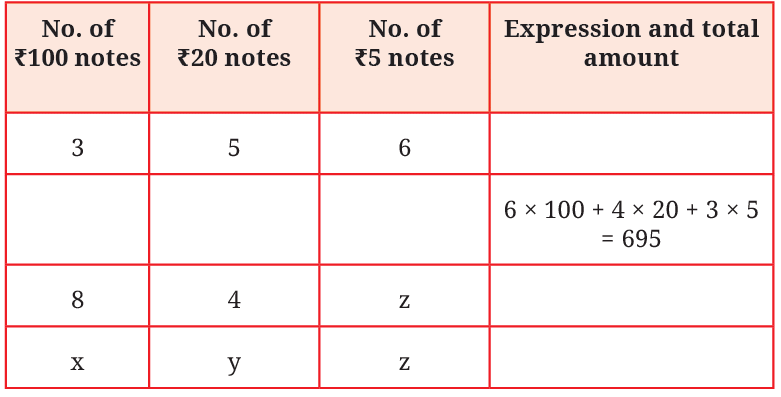 Ans:
Ans:
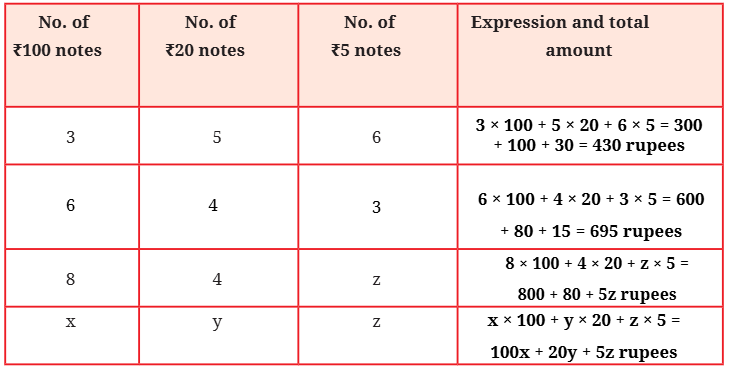
Q4: Venkatalakshmi owns a flour mill. It takes 10 seconds for the roller mill to start running. Once it is running, each kg of grain takes 8 seconds to grind into powder. Which of the expressions below describes the time taken to complete grind 'y' kg of grain, assuming the machine is off initially?
(a) 10 + 8 + y
(b) (10 + 8) × y
(c) 10 × 8 × y
(d) 10 + 8 × y
(e) 10 × y + 8
Ans: Time taken by the roller mill to start running = 10 seconds
Time taken by the roller mill to grind each kg of grain to powder = 8 seconds
Therefore, expression for the time taken to complete grind y kg of grain = 10 + 8 × y
Thus, expression (d) 10 + 8 × y describe the given condition.
Q5: Write algebraic expressions using letters of your choice.
(a) 5 more than a number
Ans: Let the number be represented by x.
The expression for 5 more than the number is: x + 5
(b) 4 less than a number
Ans: Let the number be represented by x.
The expression for 4 less than the number is: x - 4
(c) 2 less than 13 times a number
Ans: Let the number be represented by x.
The expression for 2 less than 13 times the number is: 13x - 2
(d) 13 less than 2 times a number
Ans: Let the number be represented by x.
The expression for 13 less than 2 times the number is: 2x - 13
Q6: Describe situations corresponding to the following algebraic expressions:
(a) 8 × x + 3 × y
Ans: Ritu bought x number of notebooks and y number of pencils. What is the. total amount she has to pay to the shopkeeper, if the cost of each notebook is ₹ 8 and cost of each pencil is ₹ 3?
(b) 15 × j - 2 × k
Ans: A carpenter earns ₹15 for each job he completes. He completes j jobs in a day. However, for each mistake he makes, he has to pay ₹2 as a fine. He makes k mistakes. How much money does he earn after paying the fines?
Q7: In a calendar month, if any 2 × 3 grid full of dates is chosen as shown in the picture, write expressions for the dates in the blank cells if the bottom middle cell has date 'w'.
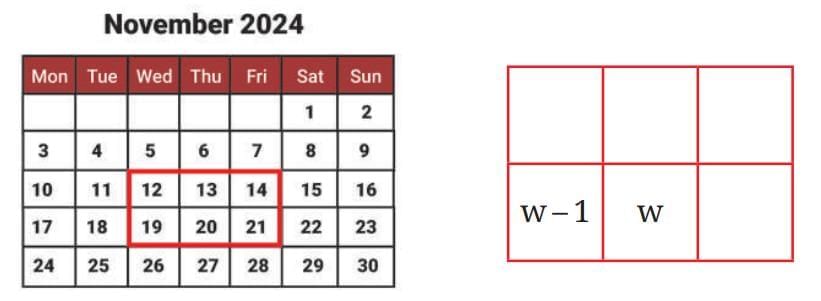
Ans:
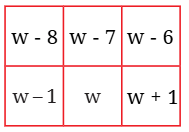
Revisiting Arithmetic Expressions
We learnt to write expressions as sums of terms and it became easy for us to read arithmetic expressions. Many times they could have been read in multiple ways and it was confusing. We used swapping (adding two numbers in any order) and grouping (adding numbers by grouping them conveniently) to find easy ways of evaluating expressions. Swapping and grouping terms does not change the value of the expression. We also learnt to use brackets in expressions, including brackets with a negative sign outside. We learnt the distributive property (multiple of a sum is the same as sum of multiples).
Find the values of the following expressions:
1. 23 – 10 × 2
2. 83 + 28 – 13 + 32
3. 34 – 14 + 20
4. 42 + 15 – (8 – 7)
5. 68 – (18 + 13)
6. 7 × 4 + 9 × 6
7. 20 + 8 × (16 – 6)
Ans: 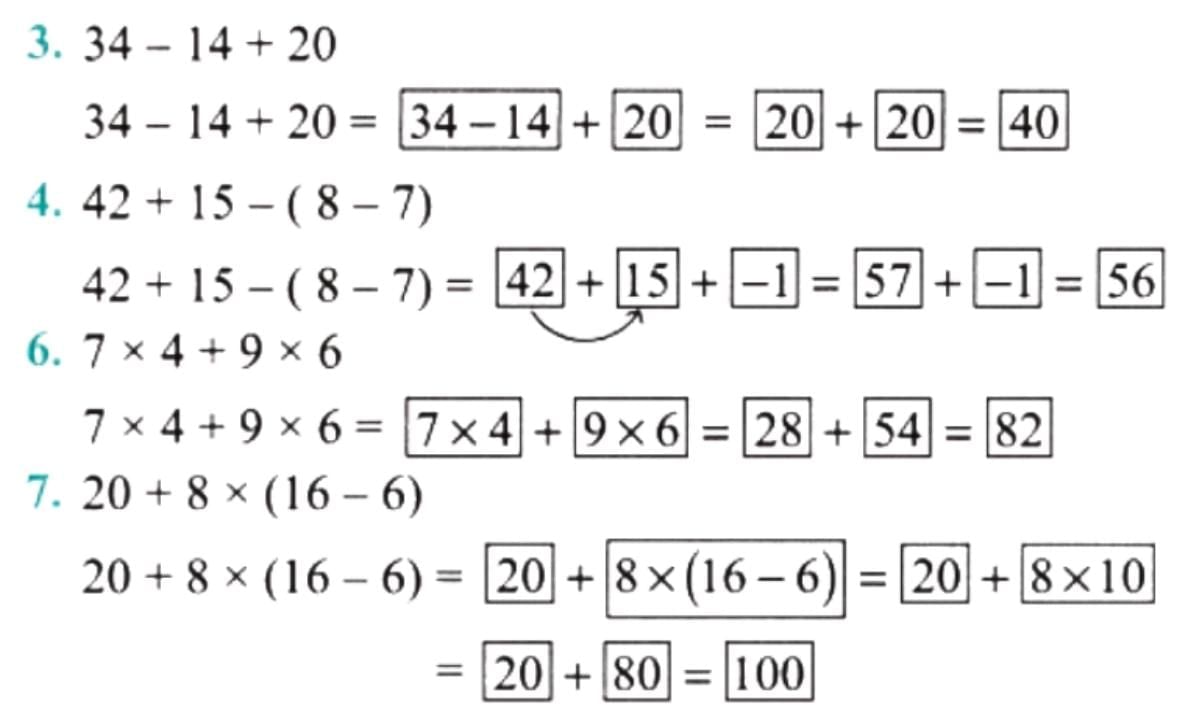
Page No. 87
Mind the Mistake, Mend the Mistake
Some simplifications are shown below where the letter-numbers are replaced by numbers and the value of the expression is obtained.
1. Observe each of them and identify if there is a mistake.
2. If you think there is a mistake, try to explain what might have gone wrong.
3. Then, correct it and give the value of the expression. 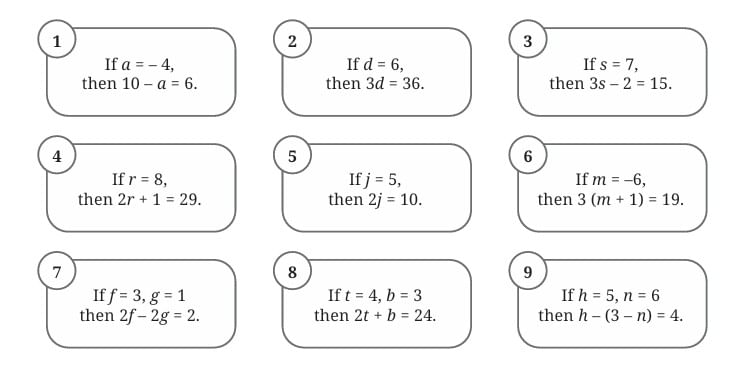 Ans: 1. If a = -4, then 10 – a = 6 is wrong.
Ans: 1. If a = -4, then 10 – a = 6 is wrong.
As 10 – a = 10 – (-4) = 10 + 4 = 14
So, if a = -4, then the correct expression is 10 – a = 14.
2. If d = 6, then 3d = 36 is wrong.
As, 3d = 3 × 6 = 18
So, if d = 6, then the correct expression is 3d = 18.
3. If s = 7, then 3s – 2 = 15 is wrong.
As 3s – 2 = 3 × 7 – 2 = 21 – 2 = 19
So, if s = 7, then the correct expression is 3s – 2 = 19.
4. If r = 8, then 2r + 1 = 29 is wrong.
As 2r + 1 = 2 × 8 + 1 = 16 + 1 = 17
So, if r = 8, then the correct expression is 2r + 1 = 17.
5. If j = 5, then 2j = 10 is correct.
As 2j = 2 × 5 = 10
6. If m = -6, then 3(m + 1) = 19 is wrong.
As 3(m + 1) = 3 × (-6 + 1) = 3 × (-5) = -15
So, if m = -6, then the correct expression is 3(m + 1) = -15.
7. If f = 3, g = 1, then 2f – 2g = 2 is wrong.
As 2f – 2g = 2 × 3 – 2 × 1 = 6 – 2 = 4
So, if f = 3, g = 1, then the correct expression is 2f – 2g = 4.
8. If t = 4, b = 3, then 2t + b = 24 is wrong.
As 2t + 6 = 2 × 4 + 3 = 8 + 3 = 11
So, if t = 4, b = 3, then the correct expression is 2t + b = 11.
9. If h = 5, n = 6, then h – (3 – n) = 4 is wrong.
As h – (3 – n) = 5 – (3 – 6) = 5 – (-3) = 5 + 3 = 8
So, if h = 5, n = 6, then the correct expression is h – (3 – n) = 8.
Page No. 88 & 89
Example 5: Here is a table showing the number of pencils and erasers sold in a shop. The price per pencil is c, and the price per eraser is d. Find the total money earned by the shopkeeper during these three days.
Let us first find the money earned by the sale of pencils.
Q: The money earned by selling pencils on Day 1 is 5c. Similarly, the money earned by selling pencils on Day 2 is _____, and Day 3 is ______.
Ans: On Day 2, the money earned = 3c.
On Day 3, the money earned = 10c.
Q2: If c = ₹50, find the total amount earned by the scale of pencils which is 18c.
Ans: Total amount earned by the sale of pencils = (5 + 3 + 10) × c
= (5 + 3 + 10) × ₹ 50
= 18 × ₹ 50
= ₹ 900
Q3: Write the expression for the total money earned by selling erasers. Then, simplify the expression.
Ans: If the price per eraser is d, then
total money earned by selling erasers = 4 × d + 6 × d + 1 × d
= 4d + 6d + d
= (4 + 6 + 1) × d
= 11 × d
= 11d
In above problem, we saw the expression 5c + 3c + 10c getting simplified to the expression 18c.
Q4: Check that both expressions take the same value when c is replaced by different numbers.
Ans: Let c = 5, then
5c + 3c + 10c = 5 × 5 + 3 × 5 + 10 × 5
= 25 + 15 + 50
= 40 + 50
= 90
And 18c = 18 × 5 = 90
Hence, both expressions take the same value when c is replaced by the number 5. Similarly, we can verify for other numbers.
Page No. 91, 92 & 93
Q: Could we have written the initial expression: (40x + 75y) – (6x + 10y) as (40x + 75y) + (– 6x – 10y)?
Ans: Yes, the expression (40x + 75y) + (– 6x – 10y) is equivalent to the original expression.
We can simplify it as follows: (40x + 75y) + (–6x – 10y) = (40x + 75y) – (6x + 10y)
Thus, both forms represent the same expression.
Example 8: Charu has been through three rounds of a quiz. Her scores in the three rounds are 7p – 3q, 8p – 4q, and 6p – 2q. Here, p represents the score for a correct answer and q represents the penalty for an incorrect answer.
What are her scores in the second and third rounds?
Sol: Her score in the second round = 8p – 4q
= 8 × 4 – 4 × 1 [As p = 4 and q = 1]
= 32 – 4
= 28
Her score in the third round = 6p – 2q
= 6 × 4 – 2 × 1 [As p = 4, q = 1]
= 24 – 2
= 22
What if there is no penalty? What will be the value of q in that situation?
Ans: If there is no penalty, then the value of q will be 0 in that situation.
Q: Give some possible scores for Krishita in the three rounds so that they add up to give 23p – 7q.
Ans: Some possible scores of Krishita in three rounds may be 8p – 4q, 9p – 2q, and 6p – q
or 7p – 3q, 10p – 3q, and 6p – q
Here 8p – 4q + 9p – 2q + 6p – q
= (8 + 9 + 6)p – (4 + 2 + 1)q
= 23p – 7q
Also 7p – 3q + 10p – 3q + 6p – q
= (7 + 10 + 6)p – (3 + 3 + 1)q
= 23p – 7q
Q: Can we say who scored more? Can you explain why? How much more has Krishita scored than Charu? This can be found by finding the difference between the two scores.
23p – 7q – (21p – 9q)
Simplify this expression further.
Ans: To find how much more Krishita has scored than Charu, we subtract Charu's score from Krishita's score: 23p – 7q – (21p – 9q)
Now, simplify the expression:
= 23p – 7q – 21p + 9q
= (23p – 21p) + (9q – 7q)
= 2p + 2q
= 2(p + q)
The value of 2p + 2q is always positive as long as both p > 0 and q > 0 (since marks and penalties are positive). So, Krishita scored 2(p + q) marks more than Charu.
Q: Fill the blanks below by replacing the letter-numbers by numbers; an example is shown. Then compare the values that 5u and 5 + u take.
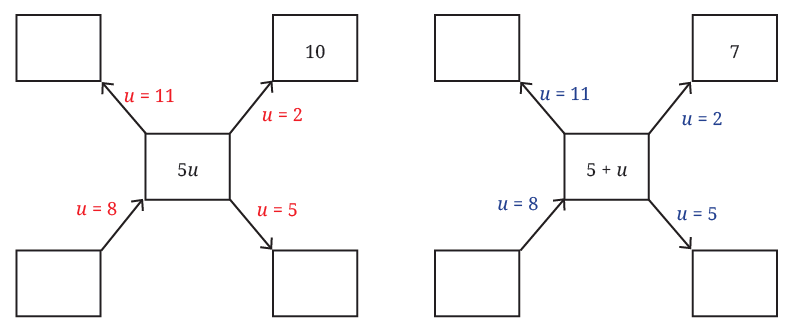 If the expressions 5u and 5 + u are equal, then they should take the same values for any given value of u. But we can see that they do not. So, these two expressions are not equal.
If the expressions 5u and 5 + u are equal, then they should take the same values for any given value of u. But we can see that they do not. So, these two expressions are not equal.
Ans:
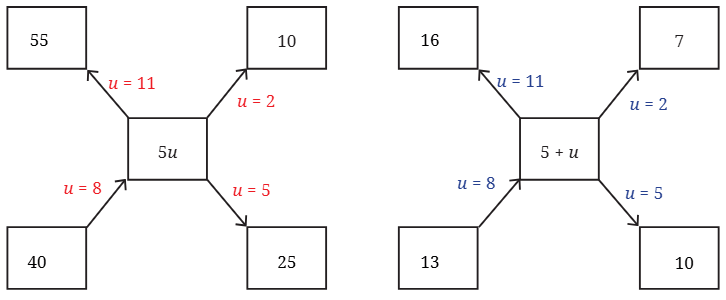
We see that the values of 5u and 5 + u are not equal for different values of u. So, the expressions 5u and 5 + u are not equal.
Q: Are the expressions 10y – 3 and 10(y – 3) equal?
10y – 3, short for 10 × y – 3, means 3 less than 10 times y,
10(y – 3), short for 10 × (y – 3), means 10 times (3 less than y).
Let us compare the values that these expressions take for different values of y.
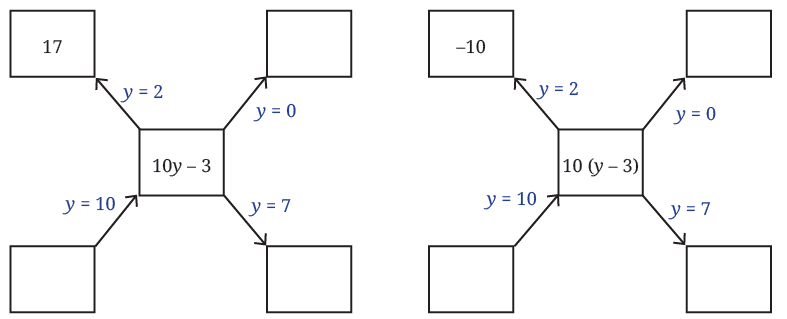 Ans:
Ans:
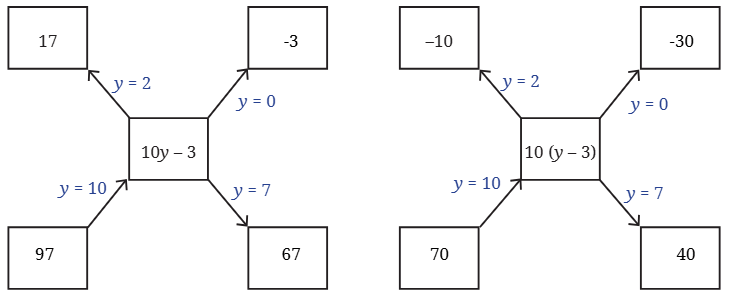
Q: After filling in the two diagrams, do you think the two expressions are equal?
Ans: We see that the values of 10y – 3 and 10(y – 3) are not equal for different values of y. So, the expressions 10y – 3 and 10(y – 3) are not equal.
Figure it Out
Q1: Add the numbers in each picture below. Write their corresponding expressions and simplify them. Try adding the numbers in each picture in a couple different ways and see that you get the same thing.

Ans: 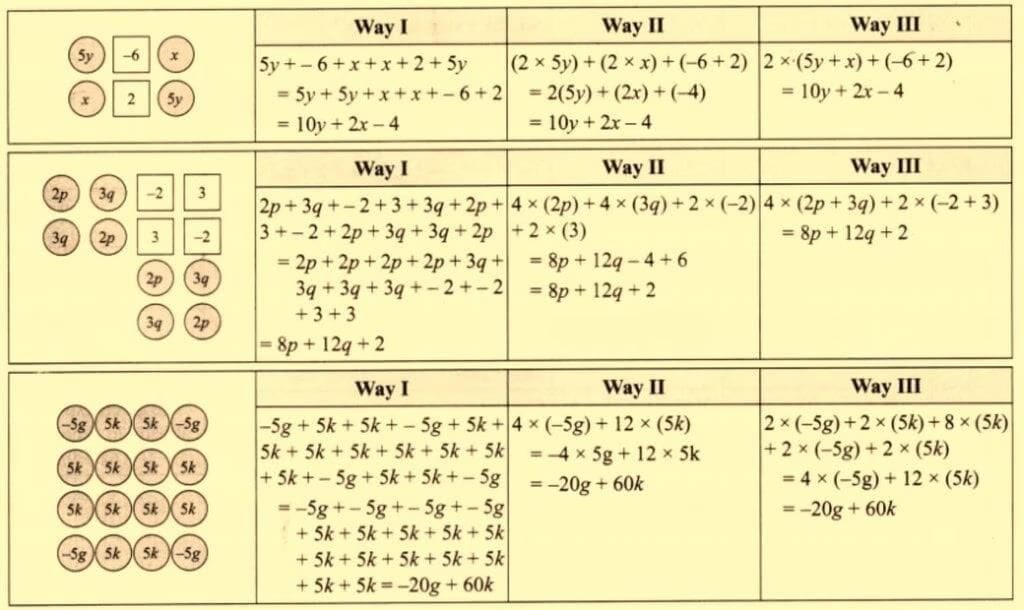
Hence, we see that while we add the expressions in different ways but the sums are always the same.
Page No. 94
Q2: Simplify each of the following expressions:
(a) Simplify the expression: p + p + p + p, p + p + p + q, p + q + p – q
Ans: p + p + p + p = 4p
p + p + p + q = 3p + q
p + q + p – q = 2p
So, the simplified expressions are 4p, 3p + q and 2p.
(b) Simplify the expression: p – q + p – q, p + q – p + q
Ans: p – q + p – q = (p + p) – (q + q) = 2p – 2q
p + q – p + q = (p – p) + (q + q) = 0 + 2q = 2q
So, the simplified expressions are 2p – 2q and 2q.
(c) Simplify the expression: p + q – (p + q), p – q – p – q
Ans: p + q – (p + q) = (p + q) – (p + q) = 0
p – q – p – q = (p – p) – (q + q) = 0 – 2q = –2q
So, the simplified expressions are 0 and –2q.
(d) Simplify the expression: 2d – d – d – d, 2d – d – d – c
Ans: 2d – d – d – d = 2d – (d + d + d) = 2d – 3d = –d
2d – d – d – c = (2d – d – d) – c = (2d – 2d) – c = 0 – c = –c
So, the simplified expressions are –d and –c.
(e) Simplify the expression: 2d – d – (d – c), 2d – (d – d) – c
Ans: 2d – d – (d – c) = (2d – d) – (d – c) = d – d + c = 0 + c = c
2d – (d – d) – c = 2d – (0) – c = 2d – c
So, the simplified expressions are c and 2d – c.
(f) Simplify the expression: 2d – d – c – c
Ans: 2d – d – c – c = (2d – d) – (c + c) = d – 2c
So, the simplified expression is d – 2c.
Mind the Mistake, Mend the Mistake
Some simplifications of algebraic expressions are done below. The expression on the right-hand side should be in its simplest form.
• Observe each of them and see if there is a mistake.• If you think there is a mistake, try to explain what might have gone wrong.
• Then, simplify it correctly.
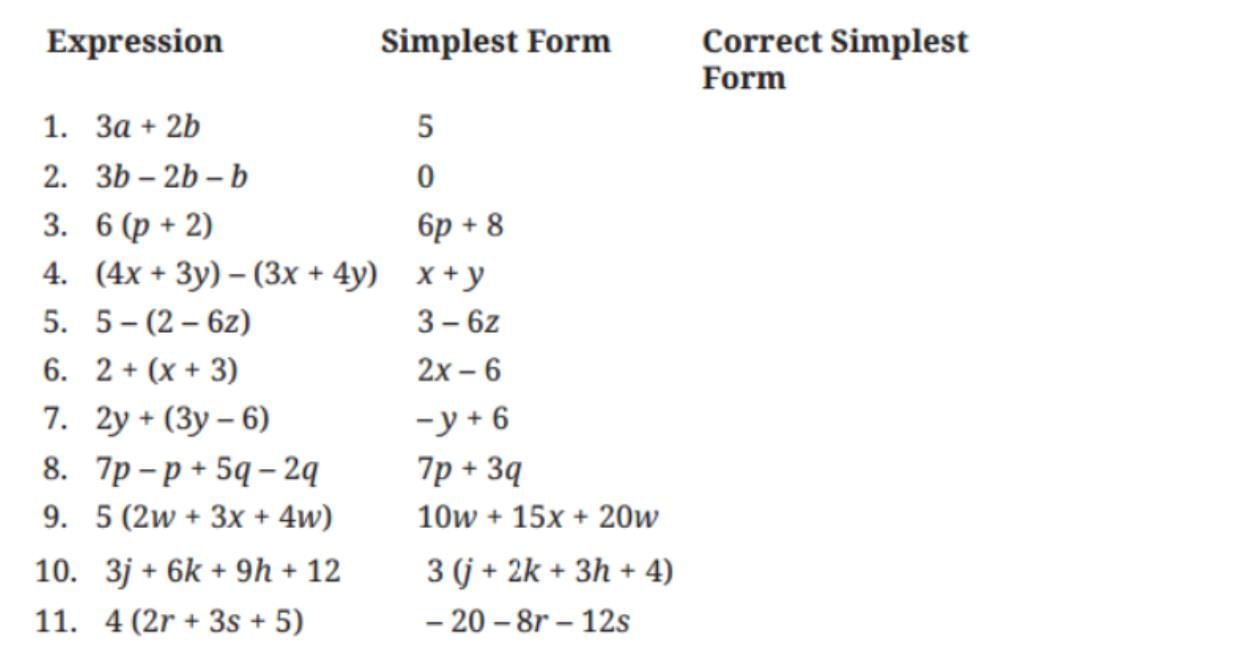
Ans: 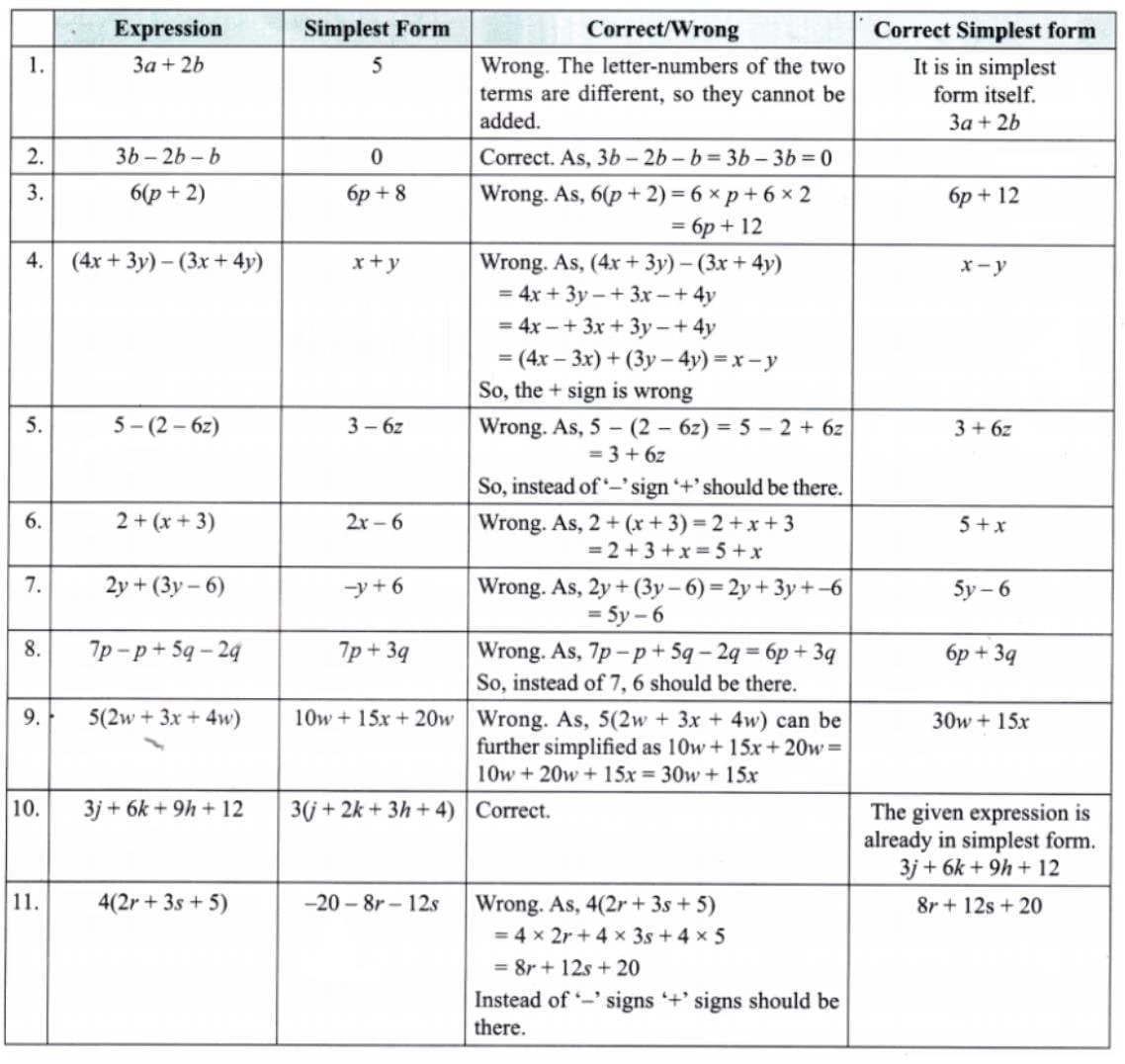
Q: Take a look at all the corrected simplest forms (i.e. brackets are removed, like terms are added, and terms with only numbers are also added). Is there any relation between the number of terms and the number of letter-numbers these expressions have?
Ans: Yes
- If the expression contains a term having only a number,
the number of terms = number of letter-numbers + 1 - If an expression has no term that has only numbers,
then number of terms = number of letter-numbers
Page No. 95, 96 & 97
Q: Find out the formula of this number machine.

The formula for the number machine above is “two times the first number minus the second number”. When written as an algebraic expression, the formula is 2a – b. The expression for the first set of inputs is 2 × 5 – 2 = 8. Check that the formula holds true for each set of inputs.

Ans: Yes, the formula holds for each set of inputs.
As, 2 × 8 – 1 = 15; 2 × 9 – 11 = 7; 2 × 10 – 10 = 10; and 2 × 6 – 4 = 8
Q: Find the formulas of the number machines below and write the expression for each set of inputs.
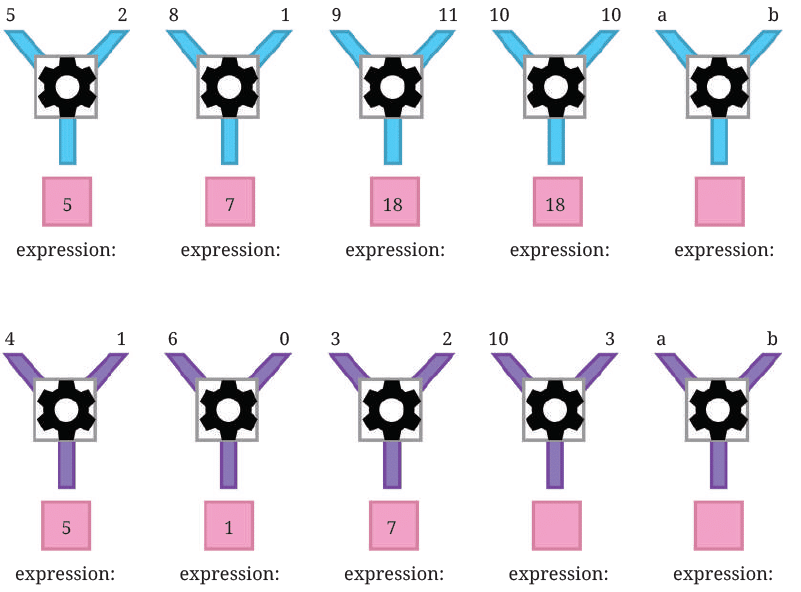 Ans: The formula for the number machines in the first row is “sum of first number and second number minus two,” and the expression is a + b – 2.
Ans: The formula for the number machines in the first row is “sum of first number and second number minus two,” and the expression is a + b – 2.
The expression for each set of inputs is:
5 + 2 – 2 = 5, 8 + 1 – 2 = 7, 9 + 11 – 2 = 18, 10 + 10 – 2 = 18, and a + b – 2.
The formula for the number machines in the second row is “product of first number and second number plus one,” and the expression is a × b + 1.
The expression for each set of inputs is:
4 × 1 + 1 = 5, 6 × 0 + 1 = 1, 3 × 2 + 1 = 7, 10 × 3 + 1 = 31, and a × b + 1 = ab + 1.
Q: Now, make a formula on your own. Write a few number machines as examples using that formula. Challenge your classmates to figure it out!
Ans: Do it Yourself.
Example 12: Somjit noticed a repeating pattern along the border of a saree.
Q: Use the table to find what design appears at positions 99, 122, and 148.
Ans:
- For 99, the remainder on division by 3 is 0, i.e., it is a multiple of 3. So, at position 99, design C will appear.
- For 122, the remainder on division by 3 is 2, i.e., it is 1 less than a multiple of 3, i.e., 3n – 1. So, at position 122, design B will appear.
- For 148, the remainder on division by 3 is 1, i.e., it is 2 less than a multiple of 3, i.e., 3n – 2. So, at position 148, design A will appear.
Page No. 98
Let us extend the numbers in the calendar beyond 30, creating endless rows.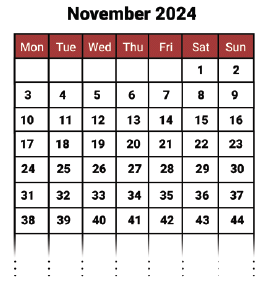 Q1: Will the diagonal sums be equal in every 2×2 square in this endless grid? How can we be sure?
Q1: Will the diagonal sums be equal in every 2×2 square in this endless grid? How can we be sure?
Ans: To be sure of this we cannot check with all 2 × 2 squares as there are an unlimited number of them. Let us consider a 2 × 2 square. Its top left number can be any number. Let us call it ‘a’.
Q2: Given that we know the top left number, how do we find the other numbers in this 2 × 2 square?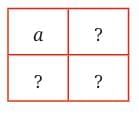
Ans: If the top left number is 'a', we can find the other numbers in the 2×2 square like this:
- Top right number: a + 1 (1 more than a)
- Bottom left number: a + 7 (7 more than a)
- Bottom right number: a + 8 (8 more than a, or diagonal to a)
So, the 2×2 square looks like:
- Top left: a
- Top right: a + 1
- Bottom left: a + 7
- Bottom right: a + 8
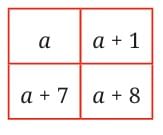
Let us find the diagonal sums; a + (a + 8), and (a + 1) + (a + 7).
Let us simplify them.
Since the terms can be added in any order, the brackets can be opened.
a + (a + 8) = a + a + 8 = 2a + 8 (a + 1) + (a + 7) = a + 1 + a + 7 = a + a + 1 + 7 = 2a + 8
We see that both diagonal sums are equal to 2a + 8 (8 more than 2 times a).
Page No. 99
Verify this expression for diagonal sums by considering any 2 × 2 square and taking its top left number to be ‘a’.
Ans: Let a = 2, then

Here, the diagonal sums are 2 + 10 = 12 and 9 + 3 = 12
And 2a + 8 = 2 × 2 + 8 = 12
Hence, the diagonal sum is equal to 2a + 8.
Consider a set of numbers from the calendar (having endless rows) forming under the following shape:
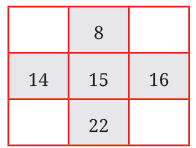
Q1: Find the sum of all the numbers. Compare it with the number in the centre: 15. Repeat this for another set of numbers that forms this shape. What do you observe?
Ans: Sum of all numbers = 8 + 14 + 15 + 16 + 22 = 75
The sum is 5 times the number in the centre.
Now, let the number at the centre: 20, then the shape is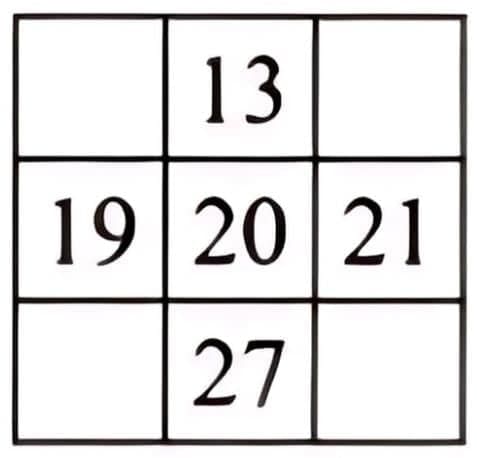
Sum of all the numbers = 13 + 19 + 20 + 21 + 27 = 100 = 20 × 5
Further, let the number at the centre: 12, then the shape is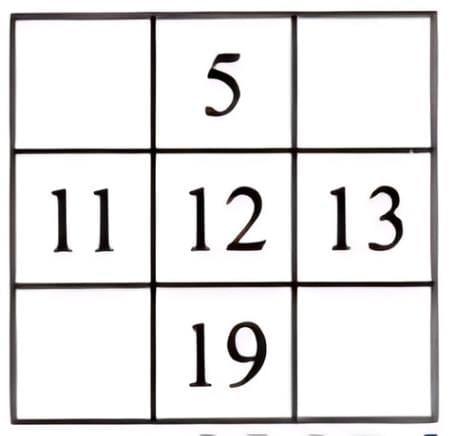
Sum of all numbers = 5 + 11 + 12 + 13 + 19 = 60 = 12 × 5
Hence, we see that the total sum is always 5 times the number in the centre.
Q2: Will this always happen? How do you show this?
Ans: Yes, this will always happen.
To show this, let's take the centre number as 'a'. The numbers around it in the shape will be:
- Top: a – 7 (7 less than a, since it's the previous row)
- Left: a – 1 (1 less than a, since it's the previous column)
- Right: a + 1 (1 more than a, since it's the next column)
- Bottom: a + 7 (7 more than a, since it's the next row)
So the numbers are: (a – 7), (a – 1), a, (a + 1), (a + 7).
Sum = (a – 7) + (a – 1) + a + (a + 1) + (a + 7)
= a – 7 + a – 1 + a + a + 1 + a + 7
= (a + a + a + a + a) + (–7 + 7) + (–1 + 1)
= 5a + 0 + 0
= 5a
The sum is 5a, which is 5 times the centre number 'a'. This works for any centre number 'a', so the sum is always 5 times the centre number.
Q: Find other shapes for which the sum of the numbers within the figure is always a multiple of one of the numbers.
Ans: Do it Yourself.
Page No. 100
Matchstick Patterns
Q1: How many matchsticks will there be in Step 33, Step 84, and Step 108? Of course, we can draw and count, but is there a quicker way to find the answers using the pattern present here?
Ans: Observed Pattern:
- Step 1: 3 matchsticks (1 triangle)
- Step 2: 5 matchsticks (2 triangles) → +2 from previous
- Step 3: 7 matchsticks (3 triangles) → +2 from previous
- ...
- Each new step adds 2 matchsticks.
General Formula:
The number of matchsticks (M) for Step n follows an arithmetic sequence: M = 3 + 2(n−1)
Simplified:
M = 2n + 1
(Where n = Step Number)
Calculations:
Matchsticks in Step 33 = (2 × 33) + 1 = 66 + 1 = 67.
Matchsticks in Step 84 = (2 × 84) + 1 = 168 + 1 = 169.
Matchsticks in Step 108 = (2 × 108) + 1 = 216 + 1 = 217.
Page No. 101 & 102
There is a different way to count, or see the pattern. Let us take a look at the picture again. Ans: In step 3, there are 3 matchsticks placed horizontally and 4 matchsticks placed diagonally. In step 4, there are 4 matchsticks placed horizontally and 5 matchsticks placed diagonally Q: How does the number of matchsticks change in each orientation as the steps increase? Write an expression for the number of matchsticks at Step 'y' in each orientation. Do the two expressions add up to 2y + 1? Ans: The pattern in the horizontally placed matchsticks is: 1, 2, 3, 4,…. Q: What are these numbers in Step 3 and Step 4?
Q: What are these numbers in Step 3 and Step 4?
In general, n for the nth step.
The pattern in the diagonally placed matchsticks is: 2, 3, 4, 5,….
In general, n + 1 for the nth step.
∴ The number of matchsticks placed horizontally at step ‘y’ is y.
The number of matchsticks placed diagonally at step ‘y’ is y + 1.
Now, these two expressions add up to y + y + 1 = 2y + 1.Figure it Out
For the problems asking you to find suitable expression(s), first try to understand the relationship between the different quantities in the situation described. If required, assume some values for the unknowns and try to find the relationship.
Q1: One plate of Jowar roti costs 30 and one plate of Pulao costs 20. If x plates of Jowar roti and y plates of pulao were ordered in a day, which expression(s) describe the total amount in rupees earned that day?
(a) 30x + 20y
(b) (30 + 20) × (x + y)
(c) 20x + 30y
(d) (30 + 20) × x + y
(e) 30x - 20y
Ans: (a) 30x + 20y
Explanation: Cost of one plate of Jowar roti = ₹ 30
∴ Cost of x plate of Jowar roti = 30x
Cost of one plate of Pulao = ₹ 20
∴ Cost of y plate of Pulao = 20y
So, the expression for the total amount earned that day = 30x + 20y
Q2: Pushpita sells two types of flowers on Independence day: champak and marigold. 'p' customers only bought champak, 'q' customers only bought marigold, and 'r' customers bought both. On the same day, she gave away a tiny national flag to every customer. How many flags did she give away that day?
(a) p + q + r
(b) p + q + 2r
(c) 2 × (p + q + r)
(d) p + q + r + 2
(e) p + q + r + 1
(f) 2 × (p + q)
Ans: (a) p + q + r
Number of customers who bought only champak = p
Number of customers who bought only marigold = q
Number of customers who bought both = r
As Pushpita gave away a tiny national flag to every customer.
So, the number of flags she gives away that day = p + q + r.
Q3: A snail is trying to climb along the wall of a deep well. During the day it climbs up 'u' cm and during the night it slowly slips down 'd' cm. This happens for 10 days and 10 nights.
(a) Write an expression describing how far away the snail is from its starting position.
Ans: During the day, the snail climbs up ‘u’ cm.
During the night snail slips down d cm.
So, the net distance covered in one day is u-d.
So, in 10 days and 10 nights, the net distance covered by the snail = 10(u-d).
Hence, the expression describing how far away the snail is from it starting position is 10(u – d) cm.
(b) What can we say about the snail's movement if d > u?
Ans: If d > u, the snail slips down more than it climbs.
It means the snail will never reach the top.
Q4: Radha is preparing for a cycling race and practices daily. The first week she cycles 5 km every day. Every week she increases the daily distance cycled by 'z' km. How many kilometers would Radha have cycled after 3 weeks?
Ans: In the first week, Radha cycled 5 km every day.
So, she cycled 5 × 7 = 35 km in the first week.
In the second week, Radha cycles (5 + z) km every day.
So, she cycled (5 + z) × 7 = (35 + 7z) km in second week.
In the third week, she cycles (5 + z + z = 5 + 2z) km every day.
So, she cycled (5 + 2z) × 7 = (35 + 14z) km in third week.
So, number of kilometres Radha cycled in 3 weeks = 35 + (35 + 7z) + (35 + 14z)
= (35 + 35 + 35) + (7z + 14z)
= 105 + 21z km
Q5: In the following figure, observe how the expression w + 2 becomes 4w + 20 along one path. Fill in the missing blanks on the remaining paths. The ovals contain expressions and the boxes contain operations.
 Ans:
Ans: 
Page No. 103
Q6: A local train from Yahapur to Vahapur stops at three stations at equal distances along the way. The time taken in minutes to travel from one station to the next station is the same and is denoted by t. The train stops for 2 minutes at each of the three stations.
(a) If t = 4, what is the time taken to travel from Yahapur to Vahapur?
Ans: The train from Yahapur to Vahapur stops at 3 stations, and stops for 2 minutes at every station.
Time taken in travelling = 4t
At t = 4, time taken in travelling = 4 × 4 = 16 minutes
Time taken during stoppages = 3 × 2 = 6 minutes
So, the time taken to travel from Yahapur to Vahapur = 16 + 6 = 22 minutes
(b) What is the algebraic expression for the time taken to travel from Yahapur to Vahapur?
Ans: Let the time taken to travel from one station to another station = t
So, time taken to travel from Yahanpur to Vahapur = 4t
As there are three stoppages between these two stations, and the train stops for 2 minutes at each stoppage, therefore total time taken during stoppages = 2 × 3 = 6 minutes
So, the algebraic expression for total time taken is 4t + 6.
Q7: Simplify the following expressions:
(a) 3a + 9b - 6 + 8a - 4b - 7a + 16
Ans: (3a + 8a - 7a) + (9b - 4b) + (-6 + 16) = 4a + 5b + 10
(b) 3(3a - 3b) - 8a - 4b - 16
Ans: 9a - 9b - 8a - 4b - 16 = (9a - 8a) + (-9b - 4b) - 16 = a - 13b - 16
(c) 2(2x - 3) + 8x + 12
Ans: 4x - 6 + 8x + 12 = (4x + 8x) + (-6 + 12) = 12x + 6
(d) 8x - (2x - 3) + 12
Ans: 8x - 2x + 3 + 12 = (8x - 2x) + (3 + 12) = 6x + 15
(e) 8h - (5 + 7h) + 9
Ans: 8h - 5 - 7h + 9 = (8h - 7h) + (-5 + 9) = h + 4
(f) 23 + 4(6m - 3n) - 8n - 3m - 18
Ans: 23 + 24m - 12n - 8n - 3m - 18 = (24m - 3m) + (-12n - 8n) + (23 - 18) = 21m - 20n + 5
Q8: Add the expressions given below:
(a) 4d - 7c + 9 and 8c - 11 + 9d
Ans: 4d – 7c + 9 + 8c – 11 + 9d
= (4d + 9d) + (-7c + 8c) + (9 – 11)
= 13d + c – 2
(b) -6f + 19 - 8s and -23 + 13f + 12s
Ans: -6f + 19 – 8s + -23 + 13f + 12s
= (-6f + 13f) + (-8s + 12s) + (19 – 23)
= 7f + 4s – 4
(c) 8d - 14c + 9 and 16c - (11 + 9d)
Ans: 8d – 14c + 9 and 16c – (11 + 9d)
= 8d – 14c + 9 + 16c – 11 – 9d
= 8d – 9d – 14c + 16c + 9 – 11
= -d + 2c – 2
= 2c – d – 2
(d) 6f - 20 + 8s and 23 - 13f - 12s
Ans: 6f – 20 + 8s and 23 – 13f – 12s
= 6f – 20 + 85 + 23 – 13f – 125
= (6f – 13f) + (8s – 12s) + (-20 + 23)
= -7f – 4s + 3
(e) 13m - 12n and 12n - 13m
Ans: 13m – 12n and 12n – 13m
= 13m – 12n + 12n – 13m
= (13m – 13m) + (-12n + 12n)
= 0
(f) -26m + 24n and 26m - 24n
Ans: -26m + 24n + 26m – 24n
= (-26m + 26m) + (24n – 24n)
= 0
Q9: Subtract the expressions given below:
(a) 9a - 6b + 14 from 6a + 9b - 18
Ans: (6a + 9b – 18) – (9a – 6b + 14)
= 6a + 9b – 18 – 9a + 6b – 14
= (6a – 9a) + (9b + 6b) + (-18 – 14)
= -3a + 15b – 32
(b) -15x + 13 - 9y from 7y - 10 + 3x
Ans: (7y – 10 + 3x) – (-15x + 13 – 9y)
= 7y – 10 + 3x + 15x – 13 + 9y
= (7y + 9y) + (3x + 15x) + (-10 – 13)
= 16y + 18x – 23
(c) 17g + 9 - 7h from 11 - 10g + 3h
Ans: (11 – 10g + 3h) – (17g + 9 – 7h)
= 11 – 10g + 3h – 17g – 9 + 7h
= (11 – 9) + (-10g – 17g) + (3h + 7h)
= 2 – 27g + 10h
= 10h – 27g + 2
(d) 9a - 6b + 14 from 6a - (9b + 18)
Ans: 6a – (9b + 18) – (9a – 6b + 14)
= 6a – 9b – 18 – 9a + 6b – 14
= (6a – 9a) + (-9b + 6b) + (-18 – 14)
= -3a – 3b – 32
= -(3a + 3b + 32)
(e) 10x + 2 + 10y from -3y + 8 - 3x
Ans: (-3y + 8 – 3x) – (10x + 2 + 10y)
= -3y + 8 – 3x – 10x – 2 – 10y
= (-3y – 10y) + (-3x – 10x) + (8 – 2)
= -13y – 13x + 6
(f) 8g + 4h - 10 from 7h - 8g + 20
Ans: (7h – 8g + 20) – (8g + 4h – 10)
= 7h – 8g + 20 – 8g – 4h + 10
= (7h – 4h) + (-8g – 8g) + (20 + 10)
= 3h – 16g + 30
Q10: Describe situations corresponding to the following algebraic expressions:
(a) 8x + 3y
Ans: A shop sells pens at 8 rupees each and notebooks at 3 rupees each. If x pens and y notebooks are bought, the total cost is 8x + 3y rupees.
(b) 15x - 2x
Ans: A person earns 15 rupees per hour for x hours but spends 2 rupees per hour for x hours on transport. The net income is 15x - 2x rupees.
Q11: Imagine a straight rope. If it is cut once as shown in the picture, we get 2 pieces. If the rope is folded once and then cut as shown, we get 3 pieces. Observe the pattern and find the number of pieces if the rope is folded 10 times and cut. What is the expression for the number of pieces when the rope is folded r times and cut?
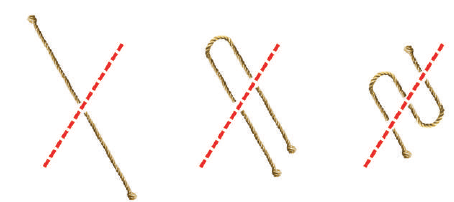 Ans: Step 1 (0 fold): We get 0 + 2 = 2 pieces
Ans: Step 1 (0 fold): We get 0 + 2 = 2 pieces
Step 2 (1 fold): We get 1 + 2 = 3 pieces
Step 3 (2 folds): We get 2 + 2 = 4 pieces
In the same way, if the rope is folded 10 times and cut, we get 10 + 2 = 12 pieces.
In the same way, when the rope is folded r times and cut, we get r + 2 pieces.
Page No. 104 & 105
Q12: Look at the matchstick pattern below. Observe and identify the pattern. How many matchsticks are required to make 10 such squares. How many are required to make w squares?
Ans: Step 1: To make 1 square, we need 4 matchsticks.
Step 2: To make 2 squares, we need 4 + 3 = 7 matchsticks
Step 3: To make 3 squares, we need 4 + 3 + 3 = 10 matchsticks.
And to make w squares we need = 4 + (w – 1) × 3
= 4 + 3(w – 1)
= (4 + 3w – 3)
= 3w + 1 matchsticks.
To make 10 squares, substitute 10 for w:
3(10) + 1 = 30 + 1 = 31 matchsticks
Q13: Have you noticed how the colours change in a traffic signal? The sequence of colour changes is shown below. Find the colour at positions 90, 190, and 343. Write expressions to describe the positions for each colour.
 Ans: The sequence of red light: 1, 5, 9, …..
Ans: The sequence of red light: 1, 5, 9, …..
In general, 4n – 3 positions
The sequence of green light: 3, 7, 11,…..
In general; 4n – 1 positions
The sequence of yellow light: 2, 4, 6, …..
In general, 2n positions
Since 90 and 190 are even numbers, it will be 2n positions.
Now, 343 ÷ 4 = 85 quotient + 3 remainder.
So, it matches a 4n-1 position.
So, colour at positions 90, 190, and 343 are yellow, yellow, and green, respectively.
Q14: Observe the pattern below. How many squares will be there in Step 4, Step 10, Step 50? Write a general formula. How would the formula change if we want to count the number of vertices of all the squares?

Ans: Number of squares in step 1 = 5
Number of squares in step 2 = 5 + 4 = 9
Number of squares in step 3 = 5 + 4 + 4 = 5 + 2 × 4 = 13
So, number of squares in step 4 = 5 + 4 + 4 + 4 = 5 + 3 × 4 = 17
So, number of squares in step 10 = 5 + 9 × 4 = 41
And, number of squares in step 50 = 5 + 49 × 4 = 201
So, the general formula = 5 + (n – 1) × 4 = 5 + 4(n – 1) = 5 + 4n – 4 = 4n + 1.
Since 1 square has 4 vertices, the number of vertices (4n + 1) squares have 4(4n + 1) = 16n + 4.
Q15: Numbers are written in a particular sequence in this endless 4-column grid.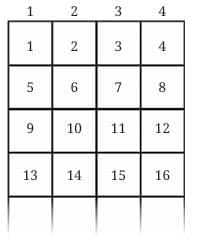
(a) Give expressions to generate all the numbers in a given column (1, 2, 3, 4).
Ans: Expression to generate all the numbers in a given column (1, 2, 3, 4)
Let r be the row number.
Column 1: 1, 5, 9, 13,…… which starts at 1 and adds 4 each row.
So, number in the rth row of column 1 = 4 × (r – 1) + 1
Column 2: 4 × (r – 1) + 2
Column 3: 4 × (r – 1) + 3
Column 4: 4 × (r – 1) + 4
If c is the column number, then the general formula to generate all numbers is 4 × (r – 1) + c.
(b) In which row and column will the following numbers appear:
(i) 124
Ans: We divide each number by 4 to find its row and column
124 ÷ 4 ⇒ Quotient = 31 and remainder is 0
∴ 124 = 4 × 31 + 0 or 4 × 30 + 4
Comparing it with 4 × (r – 1) + c, we get
r – 1 = 30, c = 4
So, r = 31 and c = 4
So, row is 31 and column is 4
(ii) 147
Ans: 147 ÷ 4 ⇒ Quotient = 36 and remainder is 3
∴ 147 = 4 × 36 + 3
Comparing it with 4 × (r – 1) + c, we get
r – 1 = 36, c = 3
So, 147 will appear at row 36 + 1 = 37 and column 3
(iii) 201
Ans: 201 ÷ 4 ⇒ Quotient = 50 and remainder is 1
∴ 201 = 4 × 50 + 1
Comparing it with 4 × (r – 1) + c, we get
r – 1 = 50, c = 1
So, 201 will appear at row 51 and column 1.
(c) What number appears in row r and column c?
Ans: The number that appears in row r and column c is 4(r – 1) + c.
(d) Observe the positions of multiples of 3. Do you see any pattern in it? List other patterns that you see.
Ans: Every third number is a multiple of 3.
We can observe that even numbers always appear in column 2 and column 4.
Odd numbers always appear in column 1 and column 3.
Every row has 2 odd and 2 even numbers.
The sum of each row increases by 16. (e.g., Row 1: 1 + 2 + 3 + 4 = 10, Row 2: 5 + 6 + 7 + 8 = 26, Row 3: 9 + 10 + 11 + 12 = 42)
|
41 videos|316 docs|8 tests
|
FAQs on NCERT Solutions for Class 7 Maths Chapter 4 Expressions Using Letter- Numbers
| 1. What are expressions using letters and numbers in mathematics? |  |
| 2. How do you evaluate an expression with a variable? |  |
| 3. What is the difference between an expression and an equation? |  |
| 4. Can you provide an example of simplifying an expression? |  |
| 5. Why are expressions important in mathematics? |  |

















